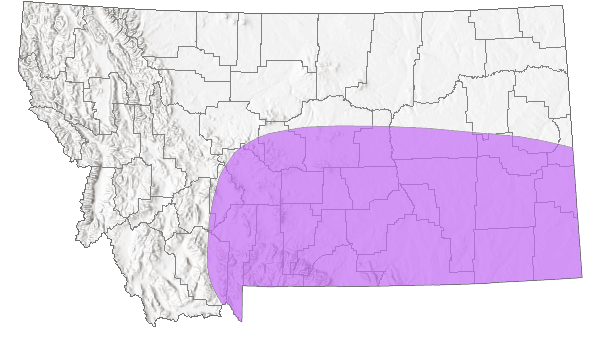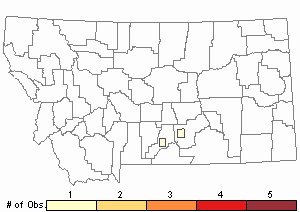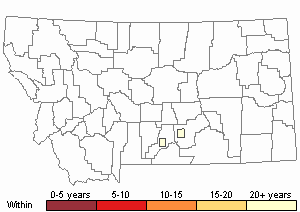View in other NatureServe Network Field Guides
NatureServe
Montana
Utah
Wyoming
Idaho
Wisconsin
British Columbia
South Carolina
Yukon
California
New York
Delicate Meadow Katydid - Orchelimum delicatum
General Description
The following is taken from Blatchley (1920), Alexander et al. (1972), Vickery and Kevan (1985), Bland (2003), and Scott (2010). The genus Orchelimum is categorized as the “greater meadow katydids” due their more stout, robust body size rather than body length, which separates them from the more slender “lesser katydids," Conocephalus genus.
The Delicate Meadow Katydid is small, pea-green (brown forms do occasionally occur), and the face is sometimes flecked with red spotting. The male 8th and 9th segments, supra-anal plate and cerci are a buttery-yellow. The tegmina (forewings) are brownish to greenish and slightly shorter than the hind wings, extending beyond the abdomen. The female ovipositor measures more than half the length of the hind femur and curves slightly upward. A dorsal dark stripe occurs only on the head and pronotum. Dorsal surface of the abdomen tends to be light yellowish and bordered only on the lateral side, anteriorly, by a short, merged edge dark stripe.
Calling song description
Verbal descriptions are: (1) “Its stridulation nearly identical to O. concinnum (which does not occur in MT) …consist of soft, rhythmic ticks and buzzes, typically two to four ticks per second followed by a buzz that lasts 1 to 2 seconds” (Bland 2003). (2) “Buzz changing speed, alternately slowing and speeding up about every 15-30 seconds; in grassy and weedy areas…” (Alexander et al. 1972). (3) “…The song consists of ticks and buzzes…the ticks are strong and audibly double” (Vickery and Kevan 1985).
Phenology
This species overwinters in the egg stage. Adults occur from the third week in July to late September (Vickery and Kevan 1985, and Bland 2003).
Diagnostic Characteristics
The following comes from Blatchley (1920), Alexander et al. (1972), Vickery and Kevan (1985), Bland (2003), and Scott (2010). The body length to end of forewings is 16 mm for males, and 17.5 mm for females. The male pronotum is 3.8 mm, and female is 4 mm. The male tegmina is 19 mm, and female is 20 mm. The male hind femur is 14 mm, and female is 15 mm, and the ovipositor is 10.5-13 mm. The ovipositor is stout and slightly curved upward. Male cercus is long with a heavy tooth (see illustration box to compare male cerci and female ovipositor morphology and size).
All the Meadow Katydids can be confused with each other. The best method for identification is to compare the measurements and forms of the female ovipositors and male cerci. Refer to the illustration above and the “diagnostic characteristics” above.
Species Range
Montana Range
Range Descriptions

 Native
Native
Range Comments
The Delicate Meadow Katydid is originally a Great Plains species, but due to the warming events of the post-glacial Xerothermic period, about 4,000 years ago (Transeau 1935, and Stuckey 1981). This species extended its range eastward where today, it is distributed from south-central Montana, across the Plains states, northern Illinois, Indiana, Michigan and northern Ohio to the Buffalo, New York area. Its northern-most occurrence is along the Canadian border of North Dakota and Minnesota, southward to New Mexico and the western half of Texas. In Montana, it has been recorded in 4 southern counties. Nowhere does this species seem to be very abundant (Transeau 1935, Gleason and Cronquist 1964, Stuckey 1981, Vickery and Kevan 1985, Scott 2010, and Walker SINA website 2020).
Observations in Montana Natural Heritage Program Database
Number of Observations: 3
(Click on the following maps and charts to see full sized version)
Map Help and Descriptions
Relative Density

Recency


 (Observations spanning multiple months or years are excluded from time charts)
(Observations spanning multiple months or years are excluded from time charts)
Habitat
The Delicate Meadow Katydid inhabits wet meadows, wet prairies, marsh edges and damp, low areas adjacent to sandy shorelines or dunes. It favors stands of
Slimstem reedgrass (
Calamagrostis stricta), and
Blue-joint reedgrass (
C. canadensis) (Vickery and Kevan 1985, and Bland 2003).
Food Habits
To date, no detailed studies nor observations specific to this species’ food habits have been found within the published literature. Its diet is probably similar to that of other species in the subfamily Conocepahlinae.
Reproductive Characteristics
To date, no detailed studies nor observations specific to this species have been found within the published literature.
Stewardship Responsibility
References
- Literature Cited AboveLegend:
 View Online Publication
View Online Publication Alexander, R.D., A.E. Pace, and D. Otte. 1972. The singing insects of Michigan. The Great Lakes Entomologist 5(2):33-69.
Alexander, R.D., A.E. Pace, and D. Otte. 1972. The singing insects of Michigan. The Great Lakes Entomologist 5(2):33-69. Bland, R.G. 2003. The Orthoptera of Michigan—Biology, Keys, and Descriptions of Grasshoppers, Katydids, and Crickets. East Lansing, MI: Michigan State University Extension, Bulletin E-2815. 221 p.
Bland, R.G. 2003. The Orthoptera of Michigan—Biology, Keys, and Descriptions of Grasshoppers, Katydids, and Crickets. East Lansing, MI: Michigan State University Extension, Bulletin E-2815. 221 p. Blatchley, W. 1920. Orthoptera of Northeastern America, section Phaneropterinae pp. 459-494. In: Nature Publishing, Indianapolis, IN.
Blatchley, W. 1920. Orthoptera of Northeastern America, section Phaneropterinae pp. 459-494. In: Nature Publishing, Indianapolis, IN. Gleason, H.A. and A. Cronquist. 1964. The natural geography of plants. New York, NY: Columbia University Press. 420 p.
Gleason, H.A. and A. Cronquist. 1964. The natural geography of plants. New York, NY: Columbia University Press. 420 p. Scott, R.D. 2010. Montana Grasshoppers, Katydids, and Crickets A Pictorial Field Guide to the Orthoptera. MagpieMTGraphics, Billings, MT.
Scott, R.D. 2010. Montana Grasshoppers, Katydids, and Crickets A Pictorial Field Guide to the Orthoptera. MagpieMTGraphics, Billings, MT. Stuckey, R.L. 1981. Origin and development of the concept of the prairie peninsula. Ohio Biological Survey Biological Notes (15):4-23.
Stuckey, R.L. 1981. Origin and development of the concept of the prairie peninsula. Ohio Biological Survey Biological Notes (15):4-23. Transeau, E.N. 1935. The prairie peninsula. Ecology 16(3):423-437.
Transeau, E.N. 1935. The prairie peninsula. Ecology 16(3):423-437. Vickery, V. R. and D. K. M. Kevan. 1985. The grasshopper, crickets, and related insects of Canada and adjacent regions. Biosystematics Research Institute, Ottawa, Ontario. Publication Number 1777. 918 pp.
Vickery, V. R. and D. K. M. Kevan. 1985. The grasshopper, crickets, and related insects of Canada and adjacent regions. Biosystematics Research Institute, Ottawa, Ontario. Publication Number 1777. 918 pp. Walker T.J.(ed.). 2020. Singing insects of North America. Accessed 10 February 2021. https://orthsoc.org/sina/
Walker T.J.(ed.). 2020. Singing insects of North America. Accessed 10 February 2021. https://orthsoc.org/sina/
- Additional ReferencesLegend:
 View Online Publication
View Online Publication
Do you know of a citation we're missing? Capinera, J.L., R.D. Scott, and T.J. Walker. 2004. Field Guide to Grasshoppers, Katydids, and Crickets of the United States. Ithaca, NY. Cornell University Press.
Capinera, J.L., R.D. Scott, and T.J. Walker. 2004. Field Guide to Grasshoppers, Katydids, and Crickets of the United States. Ithaca, NY. Cornell University Press. Fulton, B.B. 1933. Stridulating organs of female Tettigoniidae (Orthoptera). Entomological News XLIV:270-275.
Fulton, B.B. 1933. Stridulating organs of female Tettigoniidae (Orthoptera). Entomological News XLIV:270-275. Gwynne, D.T. 2001. Katydids and Bush-Crickets, Reproductive Behavior and Evolution of the Tettigoniidae. Ithaca, NY: Cornell University Press.
Gwynne, D.T. 2001. Katydids and Bush-Crickets, Reproductive Behavior and Evolution of the Tettigoniidae. Ithaca, NY: Cornell University Press. Hebard, M. 1928. The Orthoptera of Montana. Proceedings of the Academy of Natural Sciences of Philadelphia, Vol. 80:211-306.
Hebard, M. 1928. The Orthoptera of Montana. Proceedings of the Academy of Natural Sciences of Philadelphia, Vol. 80:211-306. Helfer, J.R. 1971. How to Know the Grasshoppers, Crickets, Cockroaches, and Their Allies. Revised edition (out of print), Mineola, NY: Dover Publications.
Helfer, J.R. 1971. How to Know the Grasshoppers, Crickets, Cockroaches, and Their Allies. Revised edition (out of print), Mineola, NY: Dover Publications. Morris, G.K. and T.J. Walker. 1976. Calling songs of Orchelimum meadow katydids (Tettigoniidae): I. Mechanism, terminology, and geographic distribution. The Canadian Entomologist 108(8):785-800.
Morris, G.K. and T.J. Walker. 1976. Calling songs of Orchelimum meadow katydids (Tettigoniidae): I. Mechanism, terminology, and geographic distribution. The Canadian Entomologist 108(8):785-800. Thomas, E.S. and R.D. Alexander. 1962. Systematic and behavioral studies on the meadow grasshoppers of the Orchelimum Concinnum group (Orthoptera: Tettigoniidae). Occasional Papers of the Museum of Zoology, University of Michigan No. 626:1-32.
Thomas, E.S. and R.D. Alexander. 1962. Systematic and behavioral studies on the meadow grasshoppers of the Orchelimum Concinnum group (Orthoptera: Tettigoniidae). Occasional Papers of the Museum of Zoology, University of Michigan No. 626:1-32.
- Web Search Engines for Articles on "Delicate Meadow Katydid"
- Additional Sources of Information Related to "Insects"





